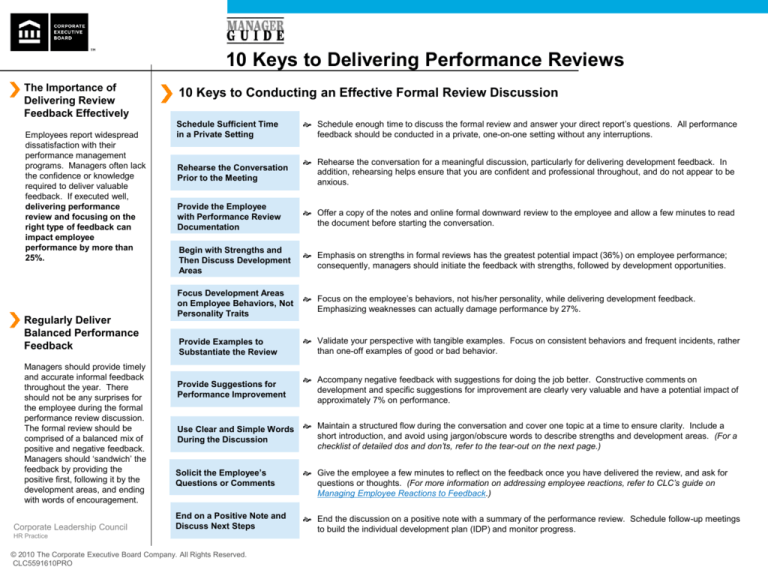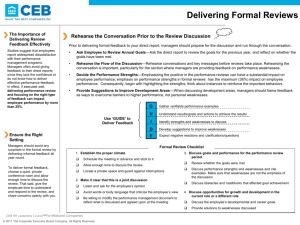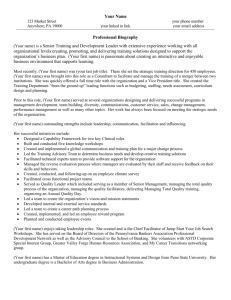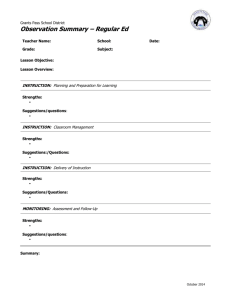
10 Keys to Delivering Performance Reviews
The Importance of
Delivering Review
Feedback Effectively
Employees report widespread
dissatisfaction with their
performance management
programs. Managers often lack
the confidence or knowledge
required to deliver valuable
feedback. If executed well,
delivering performance
review and focusing on the
right type of feedback can
impact employee
performance by more than
25%.
Regularly Deliver
Balanced Performance
Feedback
Managers should provide timely
and accurate informal feedback
throughout the year. There
should not be any surprises for
the employee during the formal
performance review discussion.
The formal review should be
comprised of a balanced mix of
positive and negative feedback.
Managers should ‘sandwich’ the
feedback by providing the
positive first, following it by the
development areas, and ending
with words of encouragement.
Corporate Leadership Council
10 Keys to Conducting an Effective Formal Review Discussion
Schedule Sufficient Time
in a Private Setting
Schedule enough time to discuss the formal review and answer your direct report’s questions. All performance
feedback should be conducted in a private, one-on-one setting without any interruptions.
Rehearse the Conversation
Prior to the Meeting
Rehearse the conversation for a meaningful discussion, particularly for delivering development feedback. In
addition, rehearsing helps ensure that you are confident and professional throughout, and do not appear to be
anxious.
Provide the Employee
with Performance Review
Documentation
Offer a copy of the notes and online formal downward review to the employee and allow a few minutes to read
the document before starting the conversation.
Begin with Strengths and
Then Discuss Development
Areas
Emphasis on strengths in formal reviews has the greatest potential impact (36%) on employee performance;
consequently, managers should initiate the feedback with strengths, followed by development opportunities.
Focus Development Areas
on Employee Behaviors, Not
Personality Traits
Focus on the employee’s behaviors, not his/her personality, while delivering development feedback.
Emphasizing weaknesses can actually damage performance by 27%.
Provide Examples to
Substantiate the Review
Validate your perspective with tangible examples. Focus on consistent behaviors and frequent incidents, rather
than one-off examples of good or bad behavior.
Provide Suggestions for
Performance Improvement
Accompany negative feedback with suggestions for doing the job better. Constructive comments on
development and specific suggestions for improvement are clearly very valuable and have a potential impact of
approximately 7% on performance.
Use Clear and Simple Words
During the Discussion
Maintain a structured flow during the conversation and cover one topic at a time to ensure clarity. Include a
short introduction, and avoid using jargon/obscure words to describe strengths and development areas. (For a
checklist of detailed dos and don’ts, refer to the tear-out on the next page.)
Solicit the Employee’s
Questions or Comments
Give the employee a few minutes to reflect on the feedback once you have delivered the review, and ask for
questions or thoughts. (For more information on addressing employee reactions, refer to CLC’s guide on
Managing Employee Reactions to Feedback.)
End on a Positive Note and
Discuss Next Steps
End the discussion on a positive note with a summary of the performance review. Schedule follow-up meetings
to build the individual development plan (IDP) and monitor progress.
HR Practice
© 2010 The Corporate Executive Board Company. All Rights Reserved.
CLC5591610PRO
10 Keys to Delivering Performance Reviews
Checklist for an Effective Review Discussion
Use the following checklist and ‘GUIDE’ acronym to deliver feedback while following the ten keys to conducting effective performance reviews (explained in the
preceding page):
Schedule sufficient time for the meeting and book a
quiet room
Use clear and simple words; do not use jargon or
Use ‘GUIDE’ to Deliver Feedback
vague language
Rehearse the conversation beforehand
Provide the employee with performance review
documentation
Maintain eye contact and a positive attitude
Begin with strengths and then discuss
development areas
Provide examples to support feedback and
G
Gather verifiable performance examples
highlight suggestions for improvement
U
Understand goals and actions to achieve results
I
Identify strengths and development areas
D
Develop suggestions for performance improvement
E
Expect clarifications and questions
Listen to the employee’s comments and reactions
End on a positive note; summarize the feedback
and highlight next steps regarding goal-setting and
individual development planning
Avoid judgmental comments and personal remarks
Performance Feedback Language—Dos and Don’ts
Managers must focus on delivering valuable feedback in a way that employees understand and accept willingly. To minimize negative employee reactions, it is
essential that managers are mindful of the language they use while delivering feedback.
DON’T
DO
Use the term ‘development areas’ when providing negative feedback.
Use positive, empathetic sentences, such as “You are professional and
diligent with project management, but your communication style is a bit
formal and leads to fragmented teamwork.”
Be descriptive, for example, “Carrie, I thought the way you managed
this was innovative and professional. I particularly liked the way you...."
Emphasize words of encouragement, for instance, “Overall, your
analytical skills are improving steadily; moving forward I will provide you
with more opportunities to develop this skill further.”
Use the words ‘weaknesses‘ and ‘poor performance.’
Employ extreme words, such as ‘always’ and ‘never.’
Include labels, such as ‘irresponsible,’ 'careless,’ and ‘awful.’
Make value judgments, such as ‘best,’ ‘bad,’ ‘incompetent.’
Compare peers, for example, “You are better than John at process
management.”
Apologize after delivering negative feedback.
Corporate Leadership Council
HR Practice
© 2010 The Corporate Executive Board Company. All Rights Reserved.
CLC5591610PRO
Sources: Corporate Leadership Council, Building the High Performance Workforce, Washington, D.C.: Corporate Executive Board, 2002.
Moulton, Stephen, “What You Need to Know About Giving Feedback”, HR.com (Date Unknown).
Boyette, Michael, “Four Keys to Delivering Effective Performance Feedback,” Hay Group (October 2009).







